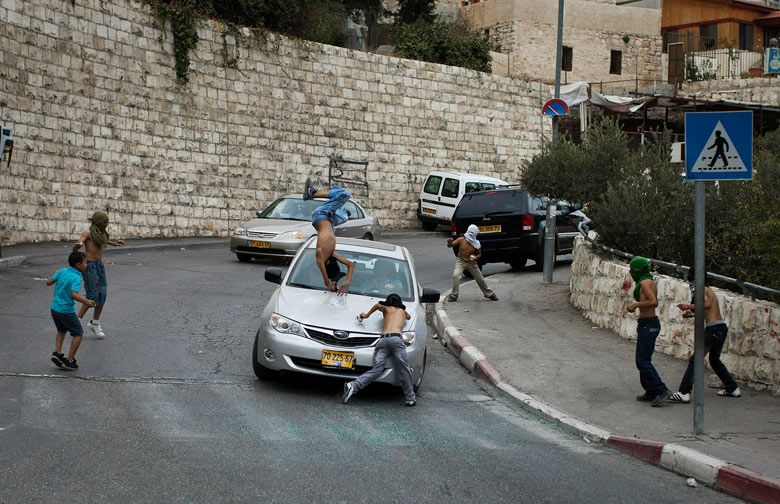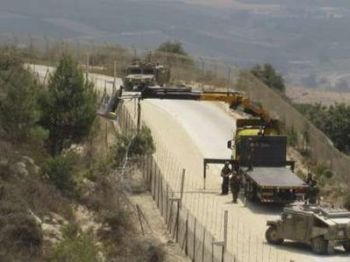Press photographers showed their true colors on Friday, colluding with Palestinian rock-throwers in Silwan.
The results: Photographers walked away with graphic photos and video footage. Imran Mansur, age 11, was left with a broken leg; Israel was smeared as the images rapidly hit the news stream.

The Guardian published an AFP/Getty Images photo with the following tip for photographers, nothing could be further from the truth:
The photographer, Ilia Yefimovich, is in the right place at the right time and captures this dramatic scene using a large depth of field and fast shutter speed.
But Yefimovich wasn’t the only photographer who simply got lucky. The incident was also captured by the Associated Press, the European Pressphoto Agency and Al Jazeera, among other news services. How did everyone manage to be in “the right place at the right time?”
HonestReporting put the question to David Katz, veteran photographer and imagery advisor. He offered four reasons why he was sure the incident was set up, with collusion between the rock-throwers and the photographers.
1. The Location
Silwan isn’t really the most tense place. Photographers waiting for stone-thowings would be more likely to go to places like Bilin or Hebron. You wouldn’t hang around Silwan unless you knew ahead of time that something was going to happen.
Also, the only photographers who can safely work in Silwan are the ones who are already known to the locals. Newcomers wouldn’t be allowed to operate, and would be in physical danger. I’ve seen it.
Confirming Katz’s latter point, an Israeli Channel 2 film crew was stoned in the same area on Sunday.
2. The Photographers’ Positions
When photographers are getting ready for something, but they’re not sure how it’s going to play out, they tend to position themselves close together. Here, the photographers are more spread out at different sides of the action. It seems everyone wanted to get their own unique position.
Israel has security cameras around Silwan, so there may be CCTV footage of what happened before, during, and after the stone-throwing. If there is, there are a few things I’d watch for. At what point did the photographers position themselves? The other cars parked there: were they deliberately put there? At what point was the back window hit? If other cars were allowed to safely pass before the stone throwing, it would shed light on whether they were targeting the driver (the driver, David Be’eri, is the director of Elad, which advocates for Jewish families living in eastern Jerusalem), or whether they just happened to get him.
If the stone throwing were really spontaneous, the kids should’ve been throwing from above. It’s safer for them, and they can do as much damage, if not more. But that’s less photogenic.
3. Reactions to the Hit and Run
When a car’s coming at you, and hits a kid, your first thought is your personal safety and what’s happening to the boy. But when you watch the video, nobody looks scared, nobody screams in horror. The children just continue throwing stones and the photographers keep snapping photos.
I have to wonder what the photographers were expecting. What would they have done if the car had stopped? Everyone there knows that when a car is stoned, the driver’s in greater danger if he just stops. Is that what the photographers thought would happen?
As human beings, the photographers should’ve warned the police. But today’s Mideast photographers are a different breed. Because of the nature of the business — it’s a cash cow — why spoil a good picture?
4. The Dynamics of Staged Stoning Attacks
Adults, perhaps one of the local elders, will tell the kids to throw stones. Another adult who has connections and friends with photographers will tip them off.
It’s absolute collusion. Why? It’s either for money, for politics, or both. The news agencies want these images because they sell, and they fit in with their worldview. Photographers know these kinds of images will move. Most importantly, if there had been no photographers present, there would have been no incident.
 It’s the same dynamic HonestReporting noted after a fatal Israeli-Lebanese border clash in August. In that incident, five Reuters photographers and others happened to be on hand on the Lebanese side of the border when Israeli soldiers doing routine maintenance work came under fire.
It’s the same dynamic HonestReporting noted after a fatal Israeli-Lebanese border clash in August. In that incident, five Reuters photographers and others happened to be on hand on the Lebanese side of the border when Israeli soldiers doing routine maintenance work came under fire.
That time, the fallout was more than a broken leg. An Israeli commander, two Lebanese soldiers, and a Lebanese journalist were killed.
In both Silwan and Lebanon, the press was tipped off ahead of time, but gave the impression that the incidents were spontaneous. They clearly weren’t. What happened in Silwan wasn’t news — it was a staged photo-op.
This is a media creation. The incident would not have happened without the presence of willing journalists and does not reflect the reality of the situation. The resulting images will be used for further propaganda, a new type of “fact” on the ground in the media battle.

